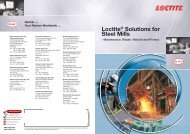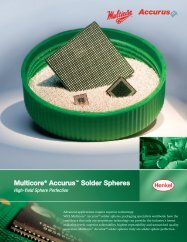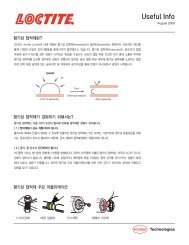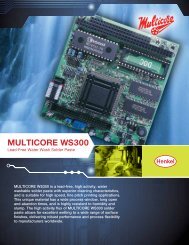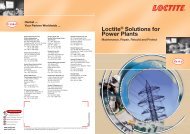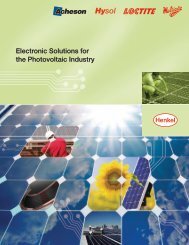Henkel Semiconductor Solutions
Henkel Semiconductor Solutions
Henkel Semiconductor Solutions
Create successful ePaper yourself
Turn your PDF publications into a flip-book with our unique Google optimized e-Paper software.
<strong>Semiconductor</strong><br />
MaTERIALS<br />
Solder MATERIALS<br />
PoP Tacky Fluxes<br />
As Package-on-Package (PoP) devices have<br />
gained favor in recent years, it has become<br />
increasingly evident that the requirements of<br />
the technology are certainly unique. This is<br />
true for many materials used to manufacture<br />
and assemble PoPs, but particularly for the<br />
tacky fluxes needed for both ball attach and for<br />
device stacking. That’s why <strong>Henkel</strong>, the leader<br />
in solder innovation, has formulated a series of<br />
Tacky Flux systems to address the demands of<br />
PoP production.<br />
PoP Epoxy Flux<br />
Combining both flux functionality and underfill<br />
protection into a single formulation, Hysol<br />
FF6000 takes PoP manufacturing flexibility<br />
to a whole new level. Traditional underfill<br />
application methodologies simply don’t work<br />
for top package assembly, but Hysol FF6000<br />
has solved this problem by incorporating a flux<br />
component that provides the action necessary<br />
for solder joint formation and an epoxy that<br />
encapsulates each solder sphere, delivering<br />
added support and protection. This streamlined<br />
approach effectively eliminates the need for<br />
dispensing equipment and the time required<br />
for underfill application and cure. But that’s<br />
not all: Hysol FF6000 has also been proven to<br />
provide improved protection – as compared to<br />
traditional flux materials – for solder sphere<br />
attach during package production as well.<br />
PoP Solder Paste<br />
When either the top or bottom package of<br />
a PoP is warped, co-planarity of the stacked<br />
packages becomes a challenge. One method<br />
used to overcome co-planarity challenges is<br />
solder paste dipping, where the top package<br />
is dipped into solder paste. Not only does the<br />
extra metallization reduce the possibility of<br />
non- co-planar induced solder joints, but it<br />
improves the joint reliability by increasing the<br />
component stand-off. The metal loading and<br />
particle size distribution of <strong>Henkel</strong>’s Multicore<br />
LF730 Solder Paste have been optimized for<br />
package stacking.<br />
Die Attach Solder Paste<br />
Multicore DA100 and Multicore DA101<br />
have been designed to provide the thermal<br />
management necessary for today’s smaller<br />
outline, higher-functioning semiconductor<br />
power devices, while also delivering the<br />
processability and versatility associated with<br />
solder paste materials. These products offer<br />
robust options for application-specific thermal<br />
requirements and overcome many of the<br />
issues historically associated with alternative<br />
products such as silver (Ag)-based Die Attach<br />
Adhesives and solder wire, neither of which is<br />
ideal for modern semiconductor power device<br />
production. The robust nature of the flux<br />
formulas provides customers the flexibility to<br />
alter alloys based on process requirements.<br />
42




